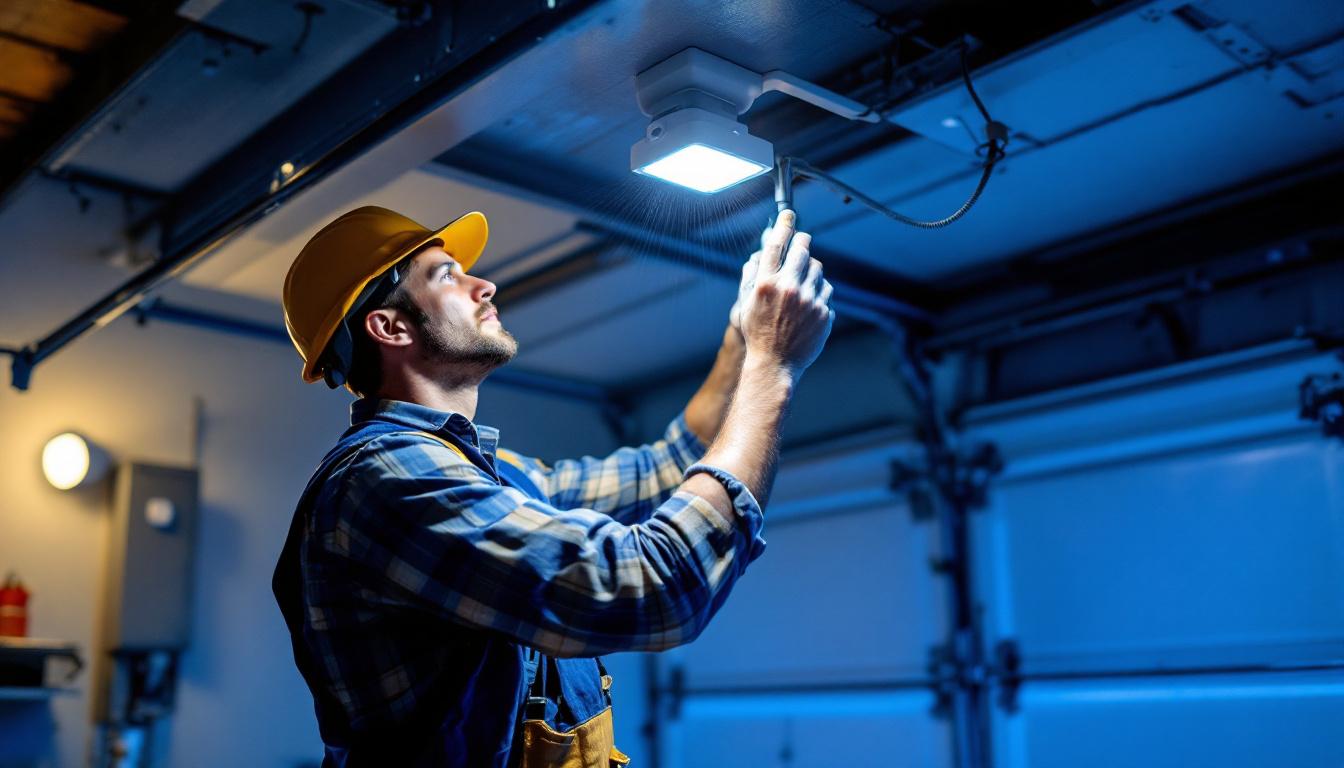
As the demand for energy-efficient solutions continues to rise, the use of motion sensor lights in garages has become increasingly popular. For lighting contractors, understanding the best practices for installing garage light motion sensors is essential to meet client expectations and ensure optimal performance. This article delves into the key considerations, installation techniques, and maintenance tips that can help lighting professionals excel in their projects.
Before diving into installation practices, it is crucial to understand the technology behind motion sensors. These devices can detect movement within a specified range and automatically activate lights, providing convenience and energy savings. There are primarily two types of motion sensors: passive infrared (PIR) and ultrasonic.
PIR sensors detect changes in infrared radiation, which is emitted by warm objects, such as humans and animals. They are ideal for outdoor and indoor applications, including garages. Their effectiveness depends on the placement and angle, as they are sensitive to movement across their field of view. Additionally, PIR sensors are typically more energy-efficient since they only activate when they sense motion, making them an excellent choice for security lighting and energy conservation. Many modern PIR sensors also come equipped with adjustable sensitivity settings, allowing users to customize their responsiveness based on the specific environment.
Ultrasonic sensors use sound waves to detect motion. They emit high-frequency sound waves and measure the reflection off moving objects. These sensors can cover a larger area compared to PIR sensors and are less affected by environmental conditions. However, they may not be as effective in spaces with significant obstacles. Ultrasonic sensors are particularly useful in environments where precise detection is necessary, such as in warehouses or large retail spaces. Their ability to detect movement even behind barriers makes them a versatile option for various applications, including automatic doors and security systems. Furthermore, advancements in technology have led to the development of dual-technology sensors that combine both PIR and ultrasonic capabilities, enhancing reliability and reducing false alarms in complex settings.
Selecting the appropriate motion sensor for a garage involves considering several factors. The size of the garage, the typical usage patterns, and the desired lighting level all play a role in determining the best fit.
The dimensions and layout of the garage are critical in selecting a motion sensor. Larger garages may require multiple sensors to ensure comprehensive coverage. Additionally, the placement of shelves, vehicles, and other objects can obstruct the sensor’s field of view, necessitating careful planning. It is also important to consider the height at which the sensors are mounted; higher placements can increase the detection range but may also lead to missed movements closer to the ground, such as pets or small children. Furthermore, the orientation of the garage door and any windows can affect how light enters the space, which can influence the sensor’s performance, particularly in daylight hours.
Knowing how clients use their garages can influence sensor choice. For example, if the garage is primarily used for parking vehicles, a sensor with a wider detection range may be beneficial. Conversely, if the space is used for storage or work, a more focused sensor might be preferable to avoid unnecessary activations. Moreover, understanding peak usage times can help in selecting sensors with adjustable sensitivity settings, allowing for tailored responses depending on the time of day. If the garage is frequently accessed during the night, it may be wise to invest in sensors that can integrate with smart lighting systems, ensuring that the area is well-lit upon entry. Additionally, incorporating features like delay settings can help prevent the lights from turning off too quickly if someone is working in the garage, enhancing both convenience and safety.
Proper installation is key to ensuring the effectiveness of motion sensor lights. Following best practices can help avoid common pitfalls and enhance the overall performance of the system.
Installing motion sensors at the right height is crucial for maximizing their effectiveness. Generally, sensors should be mounted between 6 to 10 feet above the ground. This height allows for a broader detection area while minimizing the chances of false triggers from small animals or other moving objects.
Placement is equally important. Sensors should be positioned to cover the main entry points and areas where activity is expected. Avoid placing them near heat sources, such as heaters or vents, as this can lead to false activations. Additionally, consider the angle of the sensor; a slight tilt can significantly enhance its field of view, ensuring that it captures movement across a wider area. For optimal performance, test the sensor’s range and adjust as necessary before finalizing the installation.
When installing motion sensor lights, ensuring proper wiring is essential for safety and functionality. Use appropriate gauge wire, and follow local electrical codes to avoid issues. Additionally, consider the power source; some sensors are hardwired, while others may operate on batteries. Hardwired systems often provide more reliable performance.
Furthermore, when selecting a power source, think about the location of the installation. For outdoor settings, ensure that the wiring is weatherproof and protected from the elements to prevent corrosion or damage. If opting for battery-operated sensors, choose high-quality batteries and consider using rechargeable options to reduce waste and ensure consistent power. Regular maintenance checks on the battery life and sensor functionality can help maintain optimal performance and extend the lifespan of your motion sensor lights.
Once installed, configuring the motion sensors correctly can significantly enhance their functionality. This includes adjusting sensitivity settings, timers, and detection zones.
Most motion sensors come with adjustable sensitivity settings. Lighting contractors should test these settings to find the optimal balance between responsiveness and minimizing false triggers. A sensor that is too sensitive may activate unnecessarily, while one that is not sensitive enough may fail to detect movement. It’s also important to consider environmental factors that can affect sensitivity, such as wind, rain, or even passing animals. Contractors should conduct thorough tests during different times of the day and under varying weather conditions to ensure that the sensors perform reliably without being overly reactive.
Timers determine how long the lights remain on after activation. Depending on the client’s needs, this can typically be adjusted from a few seconds to several minutes. Additionally, some sensors allow for the adjustment of detection zones, enabling contractors to customize the area monitored by the sensor. For instance, if a client has a long driveway, adjusting the detection zone to cover that area can enhance security while preventing false alarms from nearby street traffic. Furthermore, some advanced motion sensors offer features like pet immunity, which can help in homes with animals, allowing them to move freely without triggering the lights. This customization ensures that the system is tailored to the specific environment and user needs, maximizing both convenience and security.
Dust, dirt, and debris can accumulate on motion sensors, obstructing their ability to detect movement. Regular cleaning of the sensor lenses and surrounding areas can help maintain optimal performance. Additionally, periodic inspections can identify potential issues, such as loose wiring or damaged components.
Clients may encounter issues such as lights not activating or false triggers. Educating them on basic troubleshooting steps can enhance their experience. For example, if lights do not activate, checking the power source and ensuring the sensor is not obstructed are good initial steps. For persistent issues, contacting a professional may be necessary.
In an era where energy efficiency is paramount, motion sensor lights offer significant advantages. Lighting contractors can highlight these benefits to clients, emphasizing the long-term cost savings and environmental impact.
Motion sensor lights automatically turn off when no movement is detected, significantly reducing energy consumption compared to traditional lighting systems. This feature is particularly beneficial in garages, where lights may otherwise be left on for extended periods.
By installing energy-efficient lighting solutions, contractors not only meet client needs but also contribute to broader sustainability goals. Encouraging clients to adopt energy-efficient practices can enhance their satisfaction and promote a positive image for the contractor.
Effective communication with clients is essential throughout the installation process. Lighting contractors should take the time to educate clients about the features and benefits of motion sensor lights.
Clients may be unfamiliar with the technology behind motion sensors. Providing a clear explanation of how the system works, its advantages, and potential limitations can help set realistic expectations. Highlighting energy savings and convenience can make the installation more appealing.
After installation, providing clients with user manuals and support information can enhance their experience. This documentation should include guidance on adjusting settings, performing routine maintenance, and troubleshooting common issues. Offering ongoing support can foster positive relationships and encourage referrals.
Installing garage light motion sensors presents an excellent opportunity for lighting contractors to enhance their service offerings. By understanding the technology, selecting the right products, following best practices for installation, and providing ongoing support, contractors can ensure client satisfaction and foster long-term relationships. As the demand for energy-efficient solutions continues to grow, embracing these best practices will position contractors as leaders in the industry.
Ready to elevate your lighting projects with the best in motion sensor technology? Look no further than LumenWholesale, where we provide lighting contractors with the highest quality, spec-grade lighting products at unbeatable wholesale prices. Say goodbye to local distributor markups and hello to superior lighting solutions that meet the strictest industry standards. With our hassle-free bulk buying and free shipping, you can stock up on reliable, high-performance lighting for your garage installations and more, ensuring you deliver top-notch service to your clients every time. Discover the ideal combination of quality, affordability, and convenience. Visit LumenWholesale today for Wholesale Lighting at the Best Value.

Discover inspiring real-world success stories from lighting contractors who have transformed outdoor spaces with innovative landscaping light solutions.

Discover the ultimate guide to choosing the best light fixture for your closet, crafted by expert lighting contractors.

Discover the pitfalls to avoid when installing exterior hanging lantern lights.

Discover how lighting contractors can streamline classroom illumination projects with practical tips and innovative solutions.